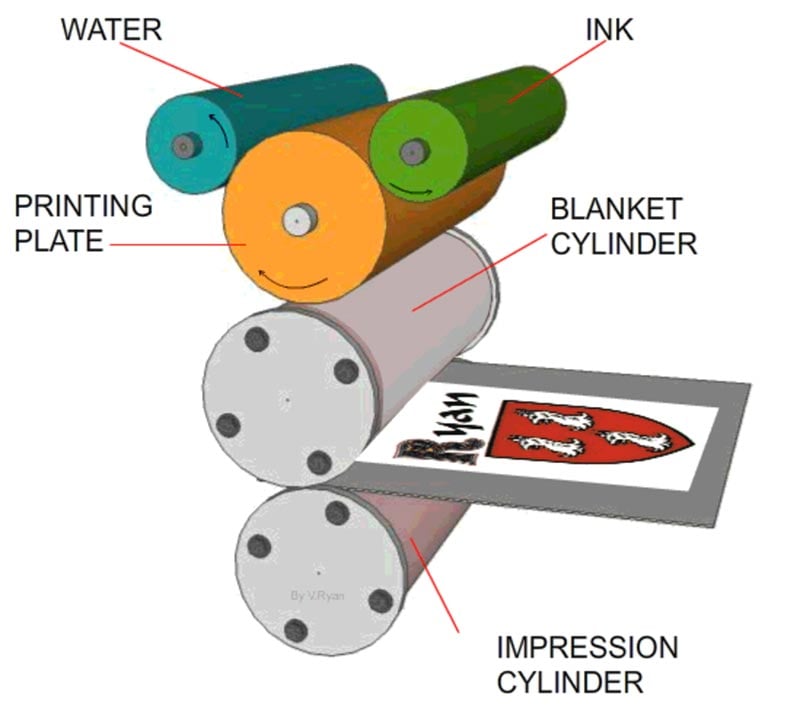A Comprehensive Guide to Recognizing Litho Printing Strategies
The globe of litho printing, a strategy stemming from the late 18th century, is a fascinating mix of history, scientific research, development and art. Remain with us as we journey into the captivating world of litho printing.
The Historical Development of Litho Printing
The historic trajectory of litho printing, a critical technology in the realm of communication, is a captivating story of human resourcefulness. The procedure advanced with the advent of the rotary press, which considerably enhanced productivity. Each phase of litho printing's development showcases humanity's relentless pursuit of performance and high quality in visual interaction.
Translating the Scientific Research Behind Litho Printing Inks
Progressing in the expedition of litho printing techniques, the emphasis now moves to the science behind litho printing inks. The structure of these inks, their drying process, and color mixing techniques form the foundation of this complicated art form. Understanding these components is essential to mastering the craft and accomplishing the desired print outcomes.
Make-up of Litho Inks
In lithographic printing, the fundamental role of litho inks can not be overstated. The make-up of litho inks differs depending on its objective, however typically, they are composed of 2 major parts - pigments and cars. Pigments, the color-providing elements, are finely ground particles suspended in the lorry, a liquid that lugs the pigment onto the printing surface area. The automobile is an intricate mix of oils, materials, and solvents, which influence the ink's drying out time, attachment, and gloss. In addition, numerous additives are present to boost particular homes like circulation, drying out, and resistance to environmental effects. Each part plays a critical component in the last print's high quality, making the specific formula of litho inks a complex scientific research.
Ink Drying Process
From the make-up of litho inks, attention turns to the fascinating procedure of ink drying. The drying procedure is crucial, as it impacts the final print's quality and durability. 2 main methods are used in litho printing: oxidative drying and absorption. Oxidative drying entails the ink reacting with oxygen in the air to develop a hard, completely dry film. This method supplies a resilient coating, however can be slower compared to absorption. Absorption, on the other hand, involves the ink permeating into the paper fibers, which is a much faster process but can lead to much less vibrant shades. The option between these approaches is dependent upon elements such as print rate needs, the paper type utilized, and the preferred surface.
Color Mixing Strategies
While the drying process plays an essential duty in litho printing, the scientific research of color blending techniques holds equal value. The science behind litho printing inks additionally takes into account the transparency of the ink, which influences how shades overlay and mix.
The Art and Design Elements in Litho Printing
Litho printing breathes life right into art and design through its one-of-a-kind elements. Litho printing fits a variety of colors, allowing musicians this link to develop vibrant and vibrant prints. This mix of accuracy and convenience makes litho printing a favored selection for several musicians and designers.
Modern Applications of Litho Printing Methods
Litho printing strategies have discovered substantial use in the contemporary industrial market. Its influence and significance proceed to grow with the introduction of new innovations and innovations in the field. This section will explore these modern applications and the transformative function they play in the printing market.
Business Litho Printing Makes Use Of
Litho printing stays a vital part of the commercial sector. High-volume printing tasks, such as the production of publications, papers, and packaging, count on litho printing for its capacity to provide remarkable picture quality and cost efficiency. Litho printing likewise supplies a wide shade range, exceptional to that of digital printing.
Innovations in Litho Printing
Pressing the borders of traditional strategies, modern-day developments have fueled a host of innovations in litho printing. These advancements have not only enhanced the top quality and performance of litho prints however additionally expanded its application extent. One noticeable development is electronic litho printing, which integrates the merits of electronic modern technology with litho's high-quality output. This hybrid version provides look at more info faster configuration times, decreased waste, and enables on-demand printing. One more significant improvement is the introduction of eco pleasant inks. These inks, made from vegetable or soy-based options, have actually considerably minimized the market's ecological impact. litho printing. In addition, the development of sophisticated plate innovation has structured the printing procedure, resulting in sharper pictures and enhanced shade fidelity. These developments emphasize the enduring relevance of litho printing in the contemporary globe.
Discovering the Refine of Litho Printing: Action by Step

Obstacles and Solutions in Contemporary Litho Printing

Regardless of the accuracy and custom that litho printing happily maintains, it is not without its collection of modern obstacles. Digital litho printing allows for economical brief runs and very easy modification, addressing the issue of variable data. Therefore, while there are obstacles, the litho printing sector is proactively adapting to fulfill them head-on, guaranteeing its significance in the future.
Verdict
In conclusion, litho printing, with its rich background and clinical ins and outs, holds a significant place in the print market. The future of litho printing pivots on its capability to adjust to these altering site here demands, affirming its enduring worth in an evolving market.
